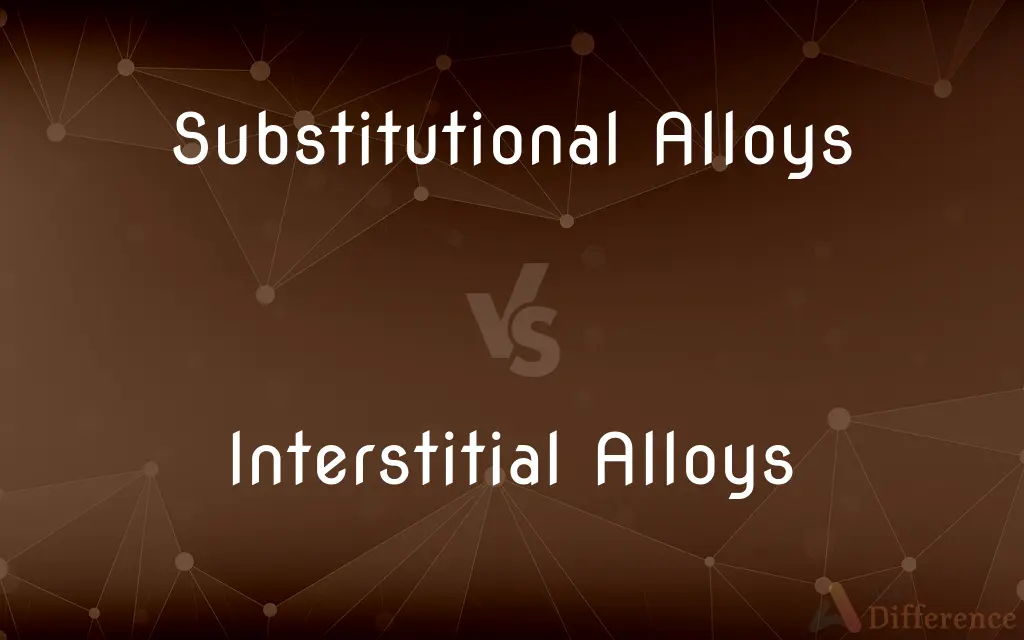Substitutional Alloys vs. Interstitial Alloys — What's the Difference?
Edited by Tayyaba Rehman — By Fiza Rafique — Published on December 8, 2023
Substitutional Alloys are formed when atoms of one metal replace those of another. Interstitial Alloys occur when small atoms fit into the spaces between larger metal atoms.

Difference Between Substitutional Alloys and Interstitial Alloys
Table of Contents
ADVERTISEMENT
Key Differences
Alloys are mixtures of metals, and they're often characterized by the manner in which they're formed at the atomic level. Substitutional Alloys are created when atoms from one metal take the place of those from another metal in its crystal lattice. In contrast, Interstitial Alloys are developed when smaller atoms position themselves in the gaps or interstices between the larger metal atoms.
The formation of Substitutional Alloys typically requires metals with similar atomic sizes and crystalline structures. This ensures the substitution of one metal atom for another without disrupting the lattice structure. On the other hand, Interstitial Alloys demand that one metal has sufficiently large atomic spaces to accommodate smaller atoms of another element.
Common examples can illustrate the distinction. Brass, made of copper and zinc, is a classic representation of Substitutional Alloys, where zinc atoms substitute for some of the copper atoms. In comparison, steel is an example of Interstitial Alloys, where carbon atoms occupy spaces in the iron lattice.
The properties of Substitutional Alloys and Interstitial Alloys can differ markedly due to their unique atomic structures. Substitutional Alloys tend to retain characteristics of their constituent metals, albeit with some modifications. Interstitial Alloys, due to the firm binding of the interstitial atoms, often exhibit increased hardness and strength compared to their base metal.
In metallurgy, the choice between producing Substitutional Alloys or Interstitial Alloys is driven by desired properties. While Substitutional Alloys might be sought for specific color or corrosion resistance, Interstitial Alloys are often chosen for their strength and durability.
ADVERTISEMENT
Comparison Chart
Atomic Arrangement
Atoms replace those of another metal
Small atoms fit into spaces of larger metal atoms
Requirement for Formation
Metals with similar atomic sizes
Large atomic spaces in one metal
Example
Brass (Copper + Zinc)
Steel (Iron + Carbon)
Typical Properties
Retain characteristics of constituent metals
Increased hardness and strength
Crystal Lattice Disruption
Minimal, due to similar atomic sizes
None, as small atoms fit in existing spaces
Compare with Definitions
Substitutional Alloys
Alloys where one metal's atoms substitute for another's.
Brass is a Substitutional Alloy of copper and zinc.
Interstitial Alloys
Metallic combinations where small atoms enhance properties by filling voids.
Adding boron to iron forms an Interstitial Alloy, often used in magnetic applications.
Substitutional Alloys
Alloys that maintain a consistent crystal lattice by substituting atoms.
Bronze, an alloy of copper and tin, is created through a substitutional process.
Interstitial Alloys
Alloys characterized by atoms occupying interstices in a metal structure.
The toughness of certain stainless steels, as Interstitial Alloys, is due to carbon's presence.
Substitutional Alloys
Mixtures formed by replacing atoms in a metal's crystal structure.
Sterling silver, a blend of silver and copper, is a Substitutional Alloy.
Interstitial Alloys
Alloys formed by inserting smaller atoms into a metal's gaps.
Steel becomes hard due to carbon atoms in iron's gaps, making it an Interstitial Alloy.
Substitutional Alloys
Metallic blends where atom replacement ensures structural integrity.
Many gold jewelry pieces are Substitutional Alloys, combining gold with metals like copper.
Interstitial Alloys
Alloys with atoms positioned between larger metal atoms, affecting characteristics.
The hardness of many tool steels, as Interstitial Alloys, results from embedded carbon atoms.
Substitutional Alloys
Alloys created when elements with similar atomic radii mix.
The creation of 10-carat gold, a Substitutional Alloy, involves gold, silver, and copper.
Interstitial Alloys
Mixtures where tiny atoms fill spaces in a metal's crystal lattice.
Titanium with added carbon is an Interstitial Alloy, enhancing its strength.
Common Curiosities
Which alloy type generally displays increased hardness?
Interstitial Alloys often exhibit greater hardness due to tightly bound interstitial atoms.
What differentiates Substitutional Alloys from Interstitial Alloys?
Substitutional Alloys involve atom replacement, while Interstitial Alloys have small atoms filling metal gaps.
Can an alloy be both substitutional and interstitial?
Yes, some alloys can exhibit both characteristics based on their compositions.
Are Substitutional Alloys made of metals with similar atomic sizes?
Typically, yes. Similar atomic sizes ensure a consistent crystal lattice in Substitutional Alloys.
What's a common example of an Interstitial Alloy?
Steel, composed of iron and carbon, is a frequently cited Interstitial Alloy.
Share Your Discovery

Previous Comparison
Upper Motor Neuron vs. Lower Motor Neuron
Next Comparison
Intergenerational Mobility vs. Intragenerational MobilityAuthor Spotlight
Written by
Fiza RafiqueFiza Rafique is a skilled content writer at AskDifference.com, where she meticulously refines and enhances written pieces. Drawing from her vast editorial expertise, Fiza ensures clarity, accuracy, and precision in every article. Passionate about language, she continually seeks to elevate the quality of content for readers worldwide.
Edited by
Tayyaba RehmanTayyaba Rehman is a distinguished writer, currently serving as a primary contributor to askdifference.com. As a researcher in semantics and etymology, Tayyaba's passion for the complexity of languages and their distinctions has found a perfect home on the platform. Tayyaba delves into the intricacies of language, distinguishing between commonly confused words and phrases, thereby providing clarity for readers worldwide.














































